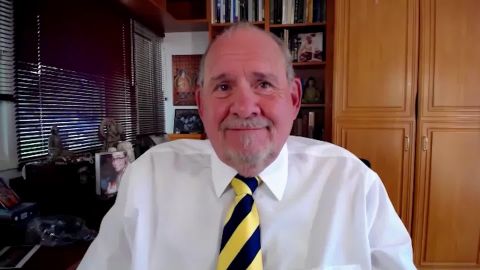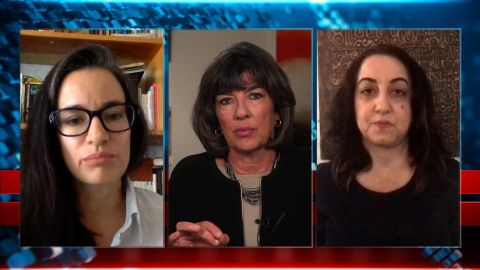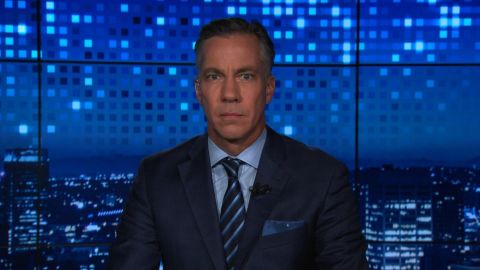Read Transcript EXPAND
CHRISTIANE AMANPOUR: So, the coronavirus rules still call for banning large gatherings, even where lockdown is slowly lifting. Nevertheless, on Saturday, President Trump is set to hold a campaign rally in Tulsa. He says the coronavirus is dying out in the U.S., but data directly contradicts him, as, this week, Oklahoma saw a record increase in new cases. And there are spikes in 23 states. Our next guest, Dr. Larry Brilliant is a physician and epidemiologist who’s been sounding the alarm about pandemics for years. And here he is talking to our Walter Isaacson about what he learned working for the WHO in India about combating viruses.
WALTER ISAACSON: Thanks, Christiane. And, Dr. Larry Brilliant, welcome to the show.
LARRY BRILLIANT, CEO, PANDEFENSE ADVISORY: Thank you, Walter. Nice to see you.
ISAACSON: You have been through a lot. And you have been through the ’60s. You were there for everything from the civil rights to the Vietnam protests to the Summer of Love, and then go off and fight pandemics in India and smallpox. But have you ever seen anything like this moment before?
BRILLIANT: No. I mean, certainly there were times in the smallpox program, with hundreds of thousands of deaths and babies, dead bodies stacked like cords of wood, when it seemed like you were in the middle of Dante’s Inferno or Hieronymus Bosch’s paintings of the end times. But, no, I have never seen a combination of a pandemic and the kind of politicization of, I mean, masks. It’s been since “The Mask of Zorro” that anybody saw a mask as a political statement. And to see these young people, these earnest, wonderful people marching in the streets for justice and human rights, and to have them crushed by a quasi-military force in Lafayette Square, no. And you add to that, speaking of crushing, the crushing of our economy by a series of reactions to the pandemic that were not scientific, but were emergency reactions, because we didn’t do the science. We gave the virus in the United States a two-week head-start, and the consequences were unthinkable. So we clamped down everything, instead of doing what we have always done in smallpox eradication and polio eradication, which is use good epidemiology, find the virus, find the contacts, put them in a cage, put the 2 percent of people in isolation who could spread the disease, and leave the 98 percent of people who were not afflicted and not a danger free. We have done everything, it seems, backwards. It’s a very troubling combination of circumstances. And if you add to it the growing, nationalism, the thugocracy, kleptocracies in country after country, it’s a very tough time. I think you would agree with that.
ISAACSON: What lessons did you learn from both smallpox and previous pandemics?
BRILLIANT: The science rules. And the virus will do what the virus will do. And we’re smarter than this little bag of RNA in a fat sack, in this case, this COVID virus, but that we can’t ignore the science. Also, I learned that pandemics will find the cracks in society. It was always the lowest caste community in India, the bricklayers, the migrant workers who would get smallpox. The wealthier people in India had already been vaccinated. And science teaches us that, if you have a vaccine, you use it. But if you don’t have a vaccine, we have plenty of other tools in our quiver — arrows in our quiver. And we haven’t been using those. If you follow what we learned in smallpox or polio eradication, or Guinea worm, you want to have a great search, a detection system, a surveillance system, and find every single case. And then we do backward tracing to find out, where were they during the incubation period or so before? We find those cases, and then we do forward tracing. We find all the people who were in contact with the case and might conceivably come down with it later. Those three groups, those who have the case, those who may have had it before, and those who might have it in the near future, those people, we quarantine. We take them out of contact with the rest of the community. What drives an outbreak like this, an epidemic like this, a pandemic like this is the density of susceptible people who are nearby a contagious case of the disease. So, by quarantining, I estimate, 1.5 or 2 percent of all the people in the United States, then the rest of the country can continue economic activity and life. Because we didn’t do that early in the outbreak, because we gave the virus an eight-week head-start, because we allowed it to expand at exponential speed, we came in with a hammer, with a cudgel. We closed the economy. And we’re bearing the consequences of that now. And it’s — indeed, it’s easier to close an economy than it is to open it again. The signals for opening are not here. So, we have put ourselves in quite a fix.
ISAACSON: Is it too late to do containment? Has it gotten out too far?
BRILLIANT: It’s never too late. It’s not as good if you wait a long time, because the virus is now seeded in every state, in most counties. But it’s never too late to do containment. Indeed, it’s the only thing that we can do, until we have a vaccine, that makes sense. Closing the economy, closing all travel, closing all places that people can go, it’s the wrong measure. You need to find out where the disease is. We are today about three weeks after Memorial Day. A few states opened before Memorial Day. Many more opened on Memorial Day. There were huge crowds at beaches and all the amusement parks trying to go out. They were so desperate to go. How can you blame them? But it is inevitable that three weeks after Memorial Day, three weeks after the Fourth of July, three weeks after Labor Day, with those crowds of people coming in contact with cases, that we will get spikes. And, Walter, it’s not a question of a second wave. We have never lost the first wave. What we’re seeing now are knock-on effects of opening up at Memorial Day.
ISAACSON: Well, are you worried about the protests in the wake of the George Floyd murder, in which people have gotten together in large crowds, since you talked about them doing so at beaches on Memorial Day, that that might help spread the virus?
BRILLIANT: I’m worried about the murder of George Floyd. I’m worried about these twin issues that we have to face right now. We have to navigate between the horrific systemic racism in the United States and the — you know, because we have talked about it in the past, that I had the privilege of marching with Dr. Martin Luther King. In one way, the first time I saw these kids in the street, it warmed my heart. I felt so good. I felt like it was just a rising up, an awakening. And then, immediately, I looked to see if everybody had masks on, of course. And most people did have a mask on. And while I don’t like the fact that people are marching very close to each other, not six feet apart, I do like the idea that they wear masks. Yes, there will be inevitable cases of COVID from people marching in the streets, but the numbers are much greater at our holidays. If you think about the hundred of millions of people who are out celebrating on Memorial Day and Fourth of July and on the roads on Labor Day in an ordinary year, and then you think about the hundreds of thousands of people who are marching in the streets, they are an addition to an already problematic resurgence of the disease.
ISAACSON: Early on in the pandemic, President Trump sort of used words like hoax or Democratic hoax or fake, and a whole lot of people still believe that. What did you think when you heard the president say that?
BRILLIANT: I was disappointed. I was angry. You can’t wish this away. This virus doesn’t care what you or I or the president says. It doesn’t care if you’re Republican, Democrat. It doesn’t care the color of your skin. This virus sees all of us as its duty to infect. And so what the president was doing was dividing us into people who now think of the mask as a political symbol. It’s insane that something that will keep you safe is a political symbol. It’s also insane to peddle snake oil. I’m sorry. Bleach is snake oil. And talking about instant cures or the virus is going to disappear in April or, the summer, it’s just going to go poof, it’s a miracle, that is not what I want from my leader, either my public health leader or the servant of the public, the president of the United States. I think what Mr. Trump has got to do is to realize that the trajectory is this virus is continuing up in the United States. We have the worst outbreak in the world. It is not too late for him to become a hero, to go back to basic epidemiology, to begin to do the kind of contact tracing, the testing, the isolation of people who are spreading the disease right now. And if he doesn’t do that, then he’s part of the problem.
ISAACSON: You have always been beloved with the CDC, the Centers for Disease Control. Do you think they truly dropped the ball when it came to, first of all, doing testing, and now trying to figure out how to do a nationwide database that allows us to understand the spread of this disease?
BRILLIANT: We don’t have a national strategy, and it should have come from CDC. CDC is a little bit like Mecca for epidemiologists. We have all trained there at some time. We go by and visit. And some of my best memories are 1600 Clifton Road in Atlanta. It’s very sad to see an institution that was uniquely revered around the world, probably greater than any other American agency, to see it fall on such hard times. Yes, it dropped the ball on testing, of course. And since then, it has been in the shadows. I think that this is not a science-first administration.
ISAACSON: What is the CDC doing wrong right now?
BRILLIANT: Well, I mean, it’s hard to understand if it’s the CDC doing wrong, or, as in the case of the guidelines that the CDC made for when to open up schools and camps and churches recently, and they did this 80-page thorough treatise on how to open up. And the administration didn’t like it. First of all, they quarantined the report, and then they had it cut down to eight pages. So, it’s hard to know if it’s the CDC expertise that is lacking or the suppression of that expertise, for reasons that just do not make any sense to me.
ISAACSON: You gave a talk in 2006 where you got to do a wish. And your wish was, help me stop pandemics. And it was very prescient. It was about pandemics that leap from animals to humans. How did you foresee that? And who else foresaw that this type of thing was going to happen?
BRILLIANT: That was my TED Talk. I get called every once in a Cassandra. Laurie Garrett is a real Cassandra. I think Bill Gates has been a Cassandra. Cassandra didn’t end up very well in Greek mythology, as you know. I think it would be hard to find epidemiologists who had the experience that I had and the experience that Laurie had who were not predicting that there would be a disease, a pandemic like this. I don’t think we get any extra credit. Indeed, I think all we have been are maybe a little bit more public mouthpieces for our science of epidemiology. Over the past 30 years, there have been some three dozen or four dozen viruses that have jumped from animals to humans. It’s only inevitable that the roulette wheel of genomics will select one of those viruses that have jumped and give it the twin characteristics that COVID has that make it so dangerous, the speed of transmission and the high rate of morbidity. And that, as long as modernity continues, as long as we cut down the rain forests, as long as we live in animals’ territory, as long as we, in West Africa and wet markets, we consume wild animals, as long as we eat more meat in places that are — where meat is grown and farmed in a way that you have these pancake houses, where on the bottom floor are pigs, in the middle are chickens, top is people, and you raise the pig, you eat it, you cut it up, and when there’s leftovers, you render them. And what do you do? You feed them to the chickens. And you raise the chickens, and you cook the chickens and you eat them. What is left over, you cut it up and render it and feed it to the pigs. I don’t know that I could have considered creating a scientific experiment that would be more efficient at creating new viruses. So, we’re living in a way the viruses jump from animals to humans at an unprecedented rate. And we have this great travel system. We have this great tourism industry that takes these viruses from the place they jump all over the world in 18 hours. So, we are on the cusp of an age of pandemics. And that makes it all the more daunting for us to deal with not just this one, but the next one. We need to re-empower CDC. We need to reestablish the person who was fired in the National Security Council who would be our eyes and ears and mouth for pandemic preparation. We need to invest in public health all over the world. None of us are safe. We need to take this as seriously as we would take war, as we would take famine, as we would take any other problem that we have faced. But we’re America, right? We can do this. But we have to focus on it. We have to take it seriously.
ISAACSON: Dr. Larry Brilliant, thank you so much for joining us.BRILLIANT: Thank you.
About This Episode EXPAND
Christiane and CNN correspondent Jim Sciutto discuss John Bolton’s forthcoming memoir, “The Room Where It Happens.” Gabriela Jauregui and journalist Farnaz Fassihi shed light on the rise of domestic abuse in areas under lockdown. Epidemiologist Dr. Larry Brilliant joins Walter Isaacson to explain what’s going wrong at the CDC.
LEARN MORE


